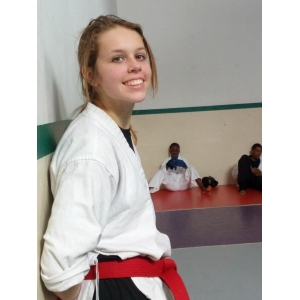This is a question that I don’t get too often but that I try to answer every time I receive a call of a potential new student. Of course most callers start the conversation with; how much do you charge? This is understandable as most people don’t understand the difference between the martial arts so they try to compare them based on a measure they understand: money. However if at any time the phrase of comparing apples to oranges ever fit in a situation this

is it.
First, let me emphasize that not all martial arts are the same. To help people understand I normally start with the basic category of “hard” versus “soft”
. In other words, schools that teach arts such as Tae Kwon Do and Karate with their brisk moves will fall under the category of hard. These techniques use a lot of force and for the most part are linear in nature. Hard styles also require greater strength for successful execution. Soft techniques are easier to identify as they make the artist appear to be dancing. The techniques have a grace within the move and require less force to be effective. Examples of soft styles are Tai Chi and Kung Fu.
Second, each school may also be identified based on their focus. In today’s day and age most schools specialize in competition. Basically their curriculum
and techniques are taught based on the rules of their competition circuit. For example, a Tae Kwon Do school that emphasize competition sparring may teach their students how to score a point and back-off. The techniques normally are quite effective but beginners may be misled as this kind of fight has no relevance to the real world. Other school like ours concentrates in the practical applications of our techniques and philosophy. In other words, rather than teaching our students how to make a form more impressive or how to score a point we teach them how to use their body in more efficient ways. Also our self-defense techniques are not about how pretty they work but how effective they will be when needed.
Third, money is a key factor but very misleading as you look for a school. I have seen schools that charge as little as thirty dollars per month while others will get five hundred on the first month and then have their customers sign a three year commitment. I have also read industry guidelines where they state that the average monthly expenditure per student should be two hundred dollars. I personally wouldn’t be able to afford that much money for martial arts lessons so in our case we price our classes based on what most people will be able to afford.
Four, who is teaching the class should be a consideration as not all black belts are the same. In the last couple of years the martial arts industry has be
come an opportunity to make money. So there has been a proliferation of black belts and a simplification of the curriculum. Granted, not all schools are the same which is the reason this becomes quite important. For example I have met instructors that call themselves “Masters” yet they have been training for less than five years. I personally have promoted about fifteen black belts in forty years. Also in our school we have three masters with a combined experience of over 100 years. We also have three of our instructors that have been inducted into the Martial Arts Hall of Fame. Yet this is not normal as most schools will be run by a second or third degree black belt.
Fifth, check to see if you are comfortable with the class you will be assigned to and the overall student population. Most people don’t think about this but there are a lot of bullies in the martial arts and at some schools these students, and sometimes instructors, like to pick on the new students. So let me apologize for these people that have polluted the spirit of the martial arts. A real school is about brotherhood and family. In our case, which may be considered taboo by many Tae Kwon Do practitioners we call our instructors Sensei. The reason this is taboo is because this is a Japanese word meaning “he who has gone before”. So using that as the basis of our school the S
enseis are considered the father of the family and the students are their kids. With time, experience and black belts of its own our senseis become Masters which for are the equivalent of grandfathers. Then a master whose students have grown to become master is by default a great-grandfather or GrandMaster. The bottomline, make sure you feel comfortable and safe in the school you choose.
In short, before selecting a martial arts schools, and at the very least consider the following:
- Soft or Hard.
- Competition or Practical Applications.
- Money.
- Instructor’s qualifications and expertise.
- Environment and culture.
So next time you decide to shop for martial arts schools first decide what you want out of this school and then have fun selecting your next “home”.
